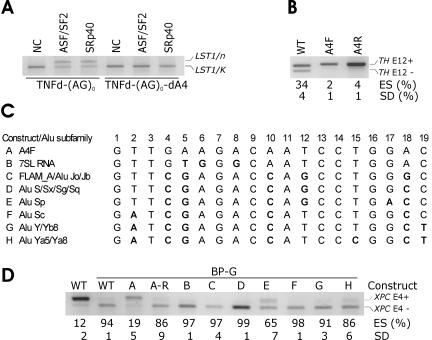FIG. 5.
Identification and characterization of Alu-derived splicing enhancer A4. (A) Deletion of A4 in TNFd-(AG)0 constructs eliminated the expression of SRp40- and ASF/SF2-induced LST1/n. We used 1 μg of plasmids expressing the two SR proteins and 0.5 μg of the reporter plasmid. NC, no-cotransfection controls. No-template controls are not shown. (B) Insertion of A4 into the TH minigene in both sense and antisense orientations resulted in full exon inclusion. The insertions were made in TH exon 12. ES, exon skipping as a ratio of transcripts lacking exon 12 (E12−) to the sum of E12− and E12+ transcripts. WT, wild type. SD, standard deviation as calculated from two transfection experiments. (C) Alignment of LST1 segment A4 with consensus sequences of Alu subfamilies. Mutations (in bold) that corresponded to sequence variations in the subfamilies were introduced in segment A4 inserted in the XPC-T construct in the sense orientation. The designation of Alu subfamilies was as described previously (2, 37). (D) Splicing of the XPC-T minigene containing the branchpoint A→G mutation could be rescued by A4F but not by A4 sequences representing most Alu subfamilies. BP-G, constructs containing the adenine-to-guanine mutation in the predicted branchpoint of XPC exon 4. Constructs A to H shown at the top correspond to mutations listed in panel C. A-R, construct with segment A4 inserted in the antisense orientation.

